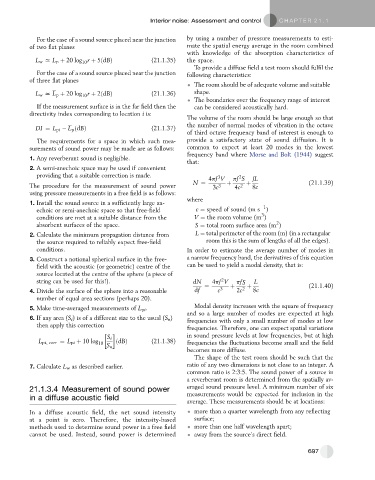Page 686 - Automotive Engineering Powertrain Chassis System and Vehicle Body
P. 686
Interior noise: Assessment and control C HAPTER 21.1
For the case of a sound source placed near the junction by using a number of pressure measurements to esti-
of two flat planes mate the spatial energy average in the room combined
with knowledge of the absorption characteristics of
L w x L p þ 20 log r þ 5ðdBÞ (21.1.35) the space.
10
To provide a diffuse field a test room should fulfil the
For the case of a sound source placed near the junction following characteristics:
of three flat planes
The room should be of adequate volume and suitable
L w x L p þ 20 log r þ 2ðdBÞ (21.1.36) shape.
10
The boundaries over the frequency range of interest
If the measurement surface is in the far field then the can be considered acoustically hard.
directivity index corresponding to location i is:
The volume of the room should be large enough so that
the number of normal modes of vibration in the octave
DI ¼ L pi L p ðdBÞ (21.1.37)
of third octave frequency band of interest is enough to
The requirements for a space in which such mea- provide a satisfactory state of sound diffusion. It is
surements of sound power may be made are as follows: common to expect at least 20 modes in the lowest
frequency band where Morse and Bolt (1944) suggest
1. Any reverberant sound is negligible.
that:
2. A semi-anechoic space may be used if convenient
providing that a suitable correction is made. 3 2
4pf V pf S fL
N ¼ þ þ (21.1.39)
The procedure for the measurement of sound power 3c 3 4c 2 8c
using pressure measurements in a free field is as follows:
where
1. Install the sound source in a sufficiently large an-
1
echoic or semi-anechoic space so that free-field c ¼ speed of sound (m s )
3
conditions are met at a suitable distance from the V ¼ the room volume (m )
2
absorbent surfaces of the space. S ¼ total room surface area (m )
2. Calculate the minimum propagation distance from L ¼ total perimeter of the room (m) (in a rectangular
the source required to reliably expect free-field room this is the sum of lengths of all the edges).
conditions. In order to estimate the average number of modes in
3. Construct a notional spherical surface in the free- a narrow frequency band, the derivatives of this equation
field with the acoustic (or geometric) centre of the can be used to yield a modal density, that is:
source located at the centre of the sphere (a piece of
2
string can be used for this!). dN 4pf V pfS L
¼ þ þ (21.1.40)
4. Divide the surface of the sphere into a reasonable df c 3 2c 2 8c
number of equal area sections (perhaps 20).
5. Make time-averaged measurements of L pi . Modal density increases with the square of frequency
and so a large number of modes are expected at high
6. If any area (S i ) is of a different size to the usual (S n ) frequencies with only a small number of modes at low
then apply this correction frequencies. Therefore, one can expect spatial variations
S i in sound pressure levels at low frequencies, but at high
L pi; corr ¼ L pi þ 10 log 10 ðdBÞ (21.1.38) frequencies the fluctuations become small and the field
S n
becomes more diffuse.
The shape of the test room should be such that the
7. Calculate L w as described earlier. ratio of any two dimensions is not close to an integer. A
common ratio is 2:3:5. The sound power of a source in
a reverberant room is determined from the spatially av-
21.1.3.4 Measurement of sound power eraged sound pressure level. A minimum number of six
measurements would be expected for inclusion in the
in a diffuse acoustic field
average. These measurements should be at locations:
In a diffuse acoustic field, the net sound intensity more than a quarter wavelength from any reflecting
at a point is zero. Therefore, the intensity-based surface;
methods used to determine sound power in a free field more than one half wavelength apart;
cannot be used. Instead, sound power is determined away from the source’s direct field.
697

